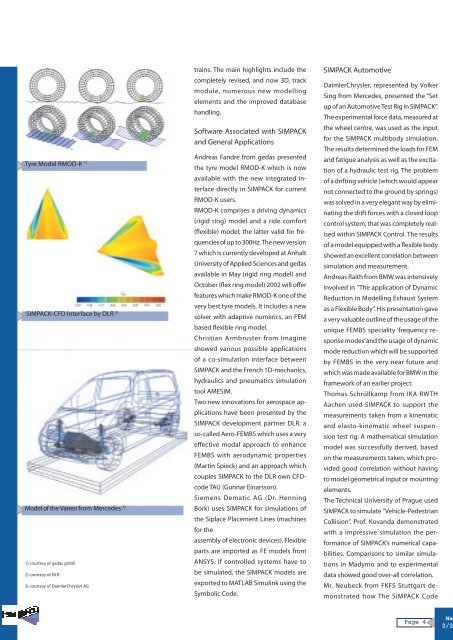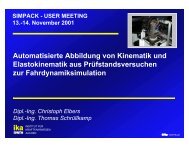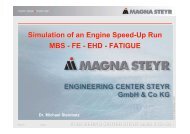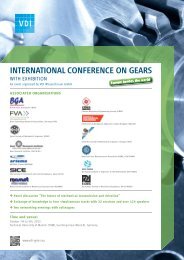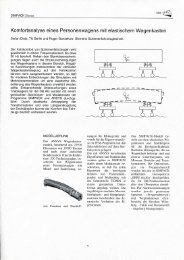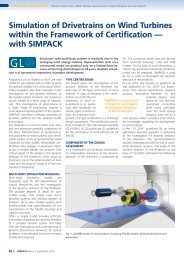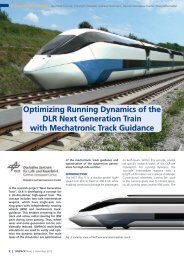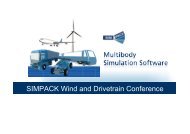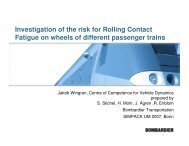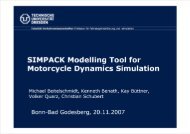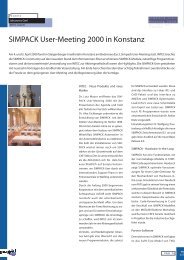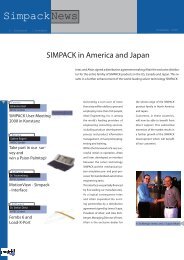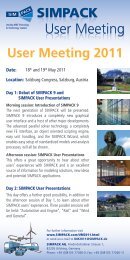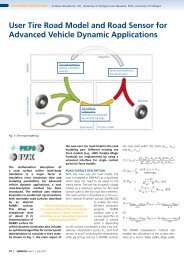SIMPACKNews
SIMPACKNews
SIMPACKNews
You also want an ePaper? Increase the reach of your titles
YUMPU automatically turns print PDFs into web optimized ePapers that Google loves.
Tyre Model RMOD-K 1)<br />
SIMPACK-CFD Interface by DLR 2)<br />
Model of the Vaneo from Mercedes 3)<br />
1) courtesy of gedas gmbh<br />
2) courtesy of DLR<br />
3) courtesy of DaimlerChrysler AG<br />
trains. The main highlights include the<br />
completely revised, and now 3D, track<br />
module, numerous new model ling<br />
elements and the im proved database<br />
handling.<br />
Software Associated with SIMP ACK<br />
and General Applications<br />
Andreas Fandre from gedas presented<br />
the tyre model RMOD-K which is now<br />
available with the new integrated interface<br />
directly in SIMPACK for current<br />
RMOD-K users.<br />
RMOD-K comprises a driving dyna mics<br />
(rigid ring) model and a ride comfort<br />
(flexible) model; the latter valid for frequencies<br />
of up to 300Hz. The new version<br />
7 which is currently developed at Anhalt<br />
Uni versity of Applied Sciences and gedas<br />
available in May (rigid ring model) and<br />
October (flex ring model) 2002 will offer<br />
features which make RMOD-K one of the<br />
very best tyre models. It includes a new<br />
solver with adaptive numerics, an FEM<br />
based flexible ring model.<br />
Christian Armbruster from Imagine<br />
showed various possible applications<br />
of a co-simulation interface between<br />
SIM PACK and the French 1D-me cha nics,<br />
hydraulics and pneumatics simulation<br />
tool AMESIM.<br />
Two new innovations for aerospace applications<br />
have been presented by the<br />
SIMPACK development partner DLR: a<br />
so-called Aero-FEMBS which uses a very<br />
effective modal approach to enhance<br />
FEMBS with aerodynamic properties<br />
(Martin Spieck) and an approach which<br />
couples SIMPACK to the DLR own CFDcode<br />
TAU (Gunnar Einarsson).<br />
Siemens Dematic AG (Dr. Henning<br />
Bork) uses SIMPACK for simulations of<br />
the Siplace Placement Lines (machines<br />
for the<br />
assembly of electronic devices). Flexible<br />
parts are imported as FE models from<br />
ANSYS. If controlled systems have to<br />
be simulated, the SIMPACK models are<br />
exported to MATLAB Simulink using the<br />
Symbolic Code.<br />
SIMPACK Automotive<br />
DaimlerChrysler, represented by Volker<br />
Sing from Mercedes, pre sented the “Set<br />
up of an Au tomotive Test Rig in SIM PACK”.<br />
The experimental force data, measured at<br />
the wheel centre, was used as the input<br />
for the SIMPACK multibody simulation.<br />
The results determined the loads for FEM<br />
and fatigue analysis as well as the excitation<br />
of a hydraulic test rig. The prob lem<br />
of a drifting vehicle (which would appear<br />
not con nected to the ground by springs)<br />
was solved in a very elegant way by eliminating<br />
the drift forces with a closed loop<br />
control system, that was completely realised<br />
within SIMPACK Control. The results<br />
of a model equipped with a flexible body<br />
showed an excellent correlation be tween<br />
simulation and mea sure ment.<br />
Andreas Raith from BMW was intensively<br />
involved in ”The application of Dynamic<br />
Reduction in Modelling Exhaust System<br />
as a Flexible Body”. His pre sentation gave<br />
a very valuable outline of the usage of the<br />
unique FEMBS speciality ‘frequency response<br />
modes’ and the usage of dynamic<br />
mode reduction which will be supported<br />
by FEMBS in the very near future and<br />
which was made available for BMW in the<br />
framework of an earlier project.<br />
Thomas Schrüllkamp from IKA RWTH<br />
Aachen used SIMPACK to support the<br />
measurements taken from a kinematic<br />
and elasto-kinematic wheel suspension<br />
test rig. A mathematical simulation<br />
model was successfully derived, based<br />
on the measurements taken, which provided<br />
good correlation without having<br />
to model geo metrical input or mounting<br />
elements.<br />
The Technical University of Prague used<br />
SIMPACK to simulate ”Vehicle-Pedestrian<br />
Collision”. Prof. Kovanda demonstrated<br />
with a impressive simulation the performance<br />
of SIM PACK’s numerical capabilities.<br />
Com parisons to similar simula-<br />
tions in Madymo and to experi mental<br />
data showed good over-all correlation.<br />
Mr. Neubeck from FKFS Stuttgart demonstrated<br />
how The SIMPACK Code<br />
Page 4<br />
Ne<br />
2/2


